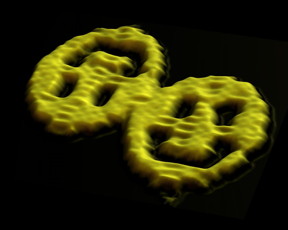'Origami' is reshaping DNA's future: Three leading researchers discuss how DNA may be used as a building material to help us develop a new generation of medicines, build electronic devices and probe the mysteries of proteins
Ten years after its introduction, DNA origami, a fast and simple way to assemble DNA into potentially useful structures, is finally coming into its own.
In a recent paper in Journal of the American Chemical Society, a team of researchers used the technique to program DNA to form large, two-dimensional honeycombs and tubes. Because those structures are assembled biologically, rather than by conventional chemical reactions, they have very precise and repeatable structures. The researchers programmed those structures to hold gold nanoparticles in arrangements that gave them unusual optical properties.

While the design certainly elicited some chuckles, Paul Rothemund’s DNA orgami method, introduced 10 years ago, gave researchers a fast and powerful way to shape DNA into useful structures.
This is just one of many potential applications for DNA origami, which uses short, easily synthesized strands of DNA to "staple" long DNA strands into complex structures.
In a roundtable, The Kavli Foundation brought together three pioneers in the field to discuss the technique's potential. They included one of the paper's co-authors, William Shih, an associate professor of Biological Chemistry and Molecular Pharmacology at Harvard Medical School and Cancer Biology at the Dana-Farber Cancer Institute.
In addition to using DNA origami to create optical devices, Shih is interested in using it to make new types of medicines. Existing drugs, he notes, are usually small molecules that "gum up the works of some process." Instead, he envisions exposing the immune system to DNA origami scaffolds that are holding pieces of virus. These complexes would "teach" the body to recognize the virus and develop antibodies to it before a live virus attacks.
"If we want to rival the immune system in effectiveness, we must rival it in complexity," Shih said in the roundtable discussion.
Other medicines might take advantage of the arrangement of proteins on cell surfaces, added Paul Rothemund, who received a MacArthur Fellowship for inventing DNA origami 10 years ago, and was one of the three participants. He is a research professor and faculty member at the Kavli Nanoscience Institute at the California Institute of Technology.
Antibodies, Rothemund argued, bind with invading molecules in atomically precise ways to neutralize them. Many researchers believe large-scale patterns of proteins on antibody surfaces control this behavior.
"DNA origami could allow us to arrange proteins in ways that give us access to the language of the immune system. This might make very sophisticated medicines possible," said Rothemund.
Rothemund also sees potential for DNA origami to integrate optically and electronically active molecules with semiconductors. Chemists already know how to synthesize single molecules that act like transistors or diodes. DNA origami could give them a way to organize those molecules into larger systems where they could interact with one another to perform computations.
"Paul [Rothemund] and I often try to compare computing with our field, which, if you think about it, involves programming biomolecules to self-assemble into whatever we want," said Shawn Douglas, an assistant professor of Cellular & Molecular Pharmacology in the University of California, San Francisco, School of Medicine. "We believe programmed biomolecules are going to be just as transformative."
One of Douglas' research interests is immobilizing proteins in DNA origami cages in order to take portraits of them using a technique called cryoelectron microscopy. This would free chemists from having to crystallize proteins, a process that is time-consuming and often fails, to understand their structure.
Douglas is also helping to move DNA programming forward in other ways. He developed caDNAno software, which enables researchers to design complex DNA origami structures. He also leads BIOMOD, an international biomolecular design competition for college students.
"If we can build out the biology the way we built out electronics, we can create all these amazing and useful things," Douglas said.
Rothemund agreed: For a long time, he says, scientists treated nature's designs as sacred, and believed that we could never fruitfully modify them.
"Today, there is a new spirit about engineering these systems, and we have tools that make these modifications easier than ever" he said. "So instead of merely studying a system, 20-year-olds are saying, 'Let's do something to make it more useful.'"
Source: Nanotechnology Now
- 329 reads
Human Rights
Ringing FOWPAL’s Peace Bell for the World:Nobel Peace Prize Laureates’ Visions and Actions

Protecting the World’s Cultural Diversity for a Sustainable Future

The Peace Bell Resonates at the 27th Eurasian Economic Summit

Declaration of World Day of the Power of Hope Endorsed by People in 158 Nations

Puppet Show I International Friendship Day 2020

